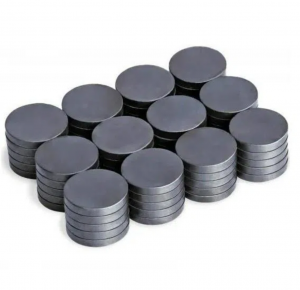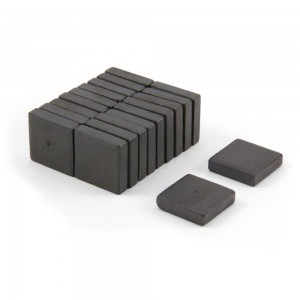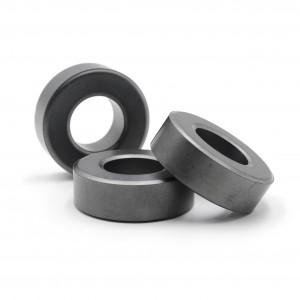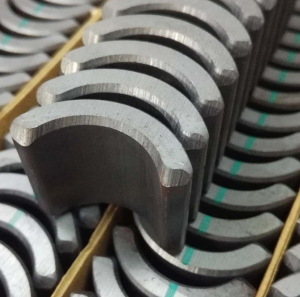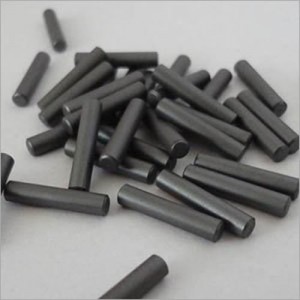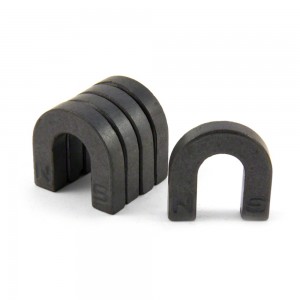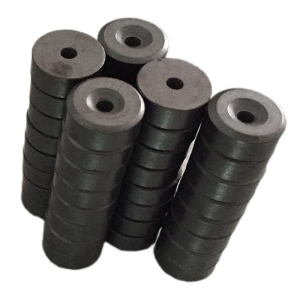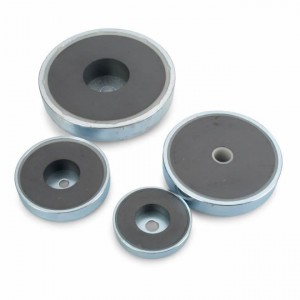About Hard Ferrite (Ceramic) Magnets
Ceramic magnets are hard ferrite magnets made by molding a powder mixture of about 80% Fe2O3 and 20% either BaCo3 or SrO3. Along with further research, additives such as cobalt (Co) and lanthanum (La) are combined to improve magnetic performance. The metallic green molded powder is sintered inside a temperature-controlled furnace that is heated by electricity or coal. Though hard ferrite magnets have low magnetic properties, they are still a preferred choice for engineers due to several factors such as abundant raw material availability, the lowest cost among permanent magnet families, low density, excellent chemistry stability, high maximum working temperature, and Curie temperature.
More than 50 companies producing hard ferrite magnets in the same city have gathered around our company. In recent years, they have been aggressively developing new magnets to meet market demand, continuously innovating techniques to improve efficiency and save costs, strictly executing ISO9001, ISO/TS16949, and 6sigm to improve quality, and firmly adhering to environmental system ISO14000 to ensure green production. The expansion of these companies provides us with numerous and competitive sources for supplying hard ferrite magnets to our global customers.
Segment Ferrite & Ring Ferrite Magnet are the most commonly marketed products and serves as an important business pillar for our company in its early stages. With the realization of increasing demand for these applications, we have focused our efforts on the promotion of arc segment-type hard ferrite magnets and have amassed extensive experience in properly producing magnets to maximize performance and optimize other application intentions. We also succeeded in developing a hard ferrite magnet with an irregular structure, complicated geometry, and high precision. Our marketed hard ferrite magnets are now widely used inside motors, generators, sensors, loudspeakers, meters, relays, separators, and a variety of other applications in defense, automotive, robotics, household appliances, wireless communication base stations, and mineral plants.
Strontium Hard Ferrite Magnet & Barium Hard Ferrite Magnet
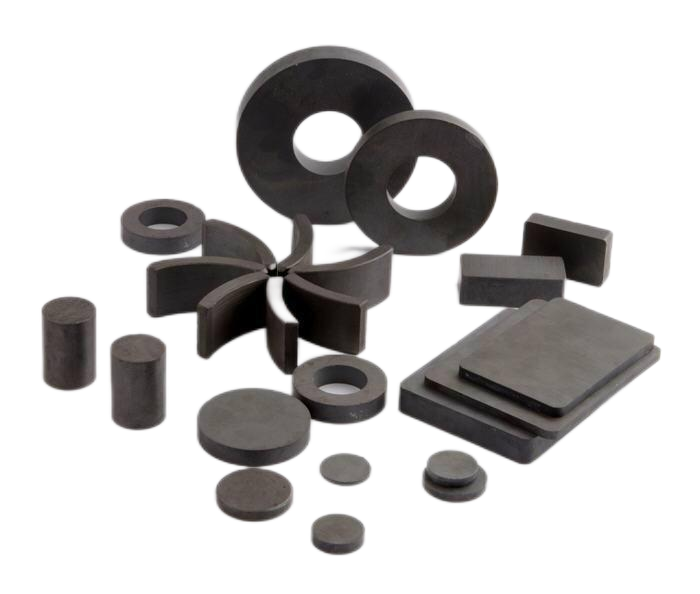
The chemical composition of barium hard ferrite magnet and strontium hard ferrite magnet is described by the formulas BaO-6Fe2O3 and SrO-6Fe2O3. Strontium hard ferrite magnet outperforms barium hard ferrite magnet in terms of magnetic performance and coercive force. Because of the lower material cost, barium hard ferrite magnets are still widely used. To achieve high magnetic properties while saving money, a mixture of strontium carbonate and barium carbonate is sometimes used to manufacture hard ferrite. Direct contact with a barium ferrite magnet
Wet Anisotropic, Dry Isotropic & Anisotropic Hard Ferrite Magnet
The majority of hard ferrite magnets are molded using a press machine equipped with a coil capable of producing an external magnetic field, resulting in an anisotropic magnet. The material used to make anisotropic hard ferrite magnets is typically in a wet slurry state, allowing molecules to be perfectly aligned during the molding process. We call magnets made by this process wet anisotropic hard ferrite magnets because they can only be magnetized along a pre-orientation. The (BH)max of anisotropic hard ferrite magnet is several orders of magnitude greater than that of isotropic hard ferrite magnet.
The raw material used to make isotropic hard ferrite magnets is typically dry powder. The molding is done with a punch machine, which cannot apply an external magnetic field to the magnet. As a result, the magnets that result are known as dry isotropic hard ferrite magnets. Magnetization on an isotropic hard ferrite magnet could take place in any desired orientation and pattern, depending on the magnetizing yoke.
Dry anisotropic hard ferrite magnets are another type of hard ferrite magnet. It is made of dry powder that has been oriented by an external magnetic field. The magnetic property of a dry anisotropic hard ferrite magnet is lower than that of a wet anisotropic hard ferrite magnet. Typically, a dry and anisotropic process is used to mold magnets with complex structures but superior properties to isotropic magnets.
Ferrite Magnet Shape & Dimensional Tolerance
A hard ferrite magnet can be economically molded with a ring, an arc segment, a rectangular, a disc, a cylinder, a trapezium, or two combined geometries in a single piece. Further machining can produce spheres, olivary shapes, and other irregular geometries based on these basic geometries. Slotting in hard ferrite magnets is possible through pre-design in tooling or diamond grinding. Wet molding can also produce hard ferrite magnets with 3S (super-small, super-big, and
Before being machined, the dimensional deviation of a hard ferrite magnet is controlled to within +/-2%, and after being simply ground with a diamond tool, it can be controlled to within +/-0.10mm. Customs tolerance or precise control of up to +/-0.015mm is possible, but must be negotiated. Wet anisotropic hard ferrite magnets are typically supplied with surfaces parallel to anisotropic orientation un-ground and other surfaces ground. For definitions of concentricity, roundness, squareness, perpendicularity, and other tolerances, please see MMPA standard No. 0100-00, DIN17410, or ISO2768.
Tooling of Hard Ferrite Magnet
Molding using tooling is the most cost-effective method for producing large quantities of hard ferrite magnets. Creating anisotropic hard ferrite magnets requires expensive tooling, whereas making isotropic hard ferrite magnets is far less expensive. We can use the ready tooling to mold alternative thickness/height magnets within the range allowed if the required magnet has the same diameter as the current tooling, or the same length and width when it is a block type.
In reality, we occasionally cut large blocks, grind larger ring or disc diameters, and machine arc segments of close dimension to the needed one. When the order quantity is not very large (especially at the prototype phase), this approach is effective for obtaining precise dimensions, saving tooling costs, and homogenizing the weight and flux of each piece of the product. The cost of machine-made magnet production is very high.
Anisotropic, Diametrically Oriented Hard Ferrite Magnet
With axial magnetization, ring-type anisotropic hard ferrite magnets are most frequently utilized (parallel to pressing orientation). There are some market needs for ring-shaped anisotropic hard ferrite magnets with diametrical magnetization (oriented perpendicular to the pressing axis), which are particularly challenging to produce. The time-rotors, sensors, stepping motors, and pump motors of household appliances, such as washing machines, dishwashers, aquariums, and heat-supply systems, are intended to utilise this type of magnet. The clash between rising magnetic force and falling product crack ratio poses a production challenge. Magnet crack will frequently occur during the sintering and shaft injection procedures. After more than ten years of research, our engineer was able to remove the bottleneck and gained some unique experience in producing this type of magnet.
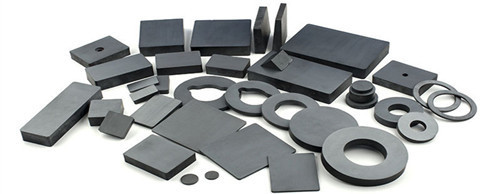
Thermal Properties of Hard Ferrite Magnet
Hard ferrite's negative temperature coefficient of remanence. Hard ferrite magnets have a positive temperature coefficient of intrinsic coercive force compared to rare earth magnets. Hard ferrite magnets' remanence will decrease as temperature rises by 0.18%/°C, whereas their intrinsic coercive force will rise by roughly 0.30%/°C. The coercive force of a hard ferrite magnet will decrease as external temperature decreases. As a result, it is advised to have components with hard ferrite magnets that do not operate at low temperatures. Hard ferrite magnets have a curie temperature of roughly 450°C. The hard ferrite magnet's recommended operating temperature range is -40°C to 250°C. Hard ferrite magnets will experience a change in grain structure when the ambient temperature reaches up to roughly 800oC. This temperature prevented the magnet from working.
Chemical Stability & Coating
Hard ferrite magnets have high chemical stability in the majority of situations. It is resistant to a wide range of substances, including brines, diluted acids, potassium and sodium hydroxides, alkaline solutions, and organic solvents. Concentrated organic and inorganic acids, including sulphuric, hydrochloric, phosphoric, hydroflouric, and oxalic acids, have the ability to etch it. Concentration, temperature, and contacting time all affect the degree and speed of etching. It does not require coating for protection because corrosion will not occur even when it operates in a humid and warm environment. It could be painted or nickel and gold plated, for example, for purposes of beauty adornment or surface cleaning.




